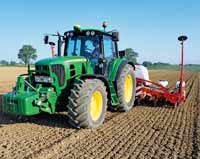Deere throws its weight behind the mobile RTK system

John Deere is the latest big company to throw its weight behind the new VRS mobile RTK network.
Normally RTK involves using either fixed or mobile base stations to get a correction signal that makes it possible to work at accuracies up to +/- 2cm. VRS, on the other hand, uses the Ordnance Survey’s 80 fixed masts to give a correction signal anywhere in the country.
It’s sent to the GPS receiver on the tractor via the GPRS mobile phone network and means there’s no need to have a base station. Trimble’s VRS Now system (and New Holland, which uses Trimble equipment) also uses the VRS system, as does Leica’s Smartnet system and Topcon’s Topnet+.
Though VRS doesn’t suffer from the signal shading effects of hills and trees that can make life difficult for mobile or fixed base stations, it does rely on having decent GPRS mobile phone coverage. And that can be distinctly patchy.
What’s different about Deere’s new Starfire mobile RTK system, according to product specialist Mark James, is that if the GPRS signal fails the receiver will automatically switch to Deere’s Starfire SF2 signal.
This may not be quite as accurate as the +/- 2cm potential accuracy of the VRS mobile RTK signal, but it should manage +/- 10cm accuracy. In fact Deere claims that for 95% of the time Starfire SF works at +/- 5cm accuracy.
The mobile RTK system can be used with any Deere Greenstar 2 in-cab display (and on other makes of tractor, too) and should be of particular interest to contractors who don’t want to cart a mobile base station around with them. It will also appeal to farmers who want a simpler way of using RTK for potato planting and ultra-precise drilling and harvesting.
Cost? Upgrading from Starfire 2 costs £2600 and the annual network subscription cost (which includes the SF2 fallback) is £1365.

